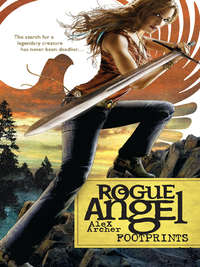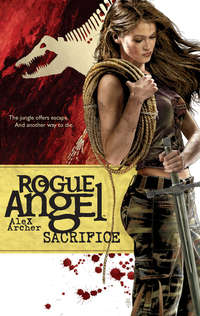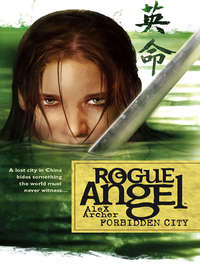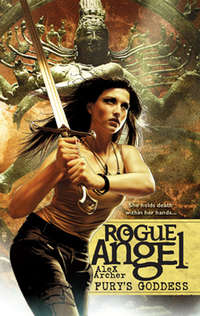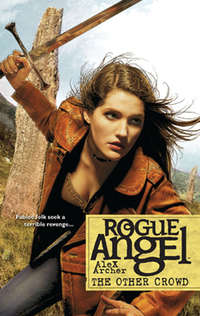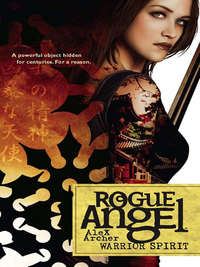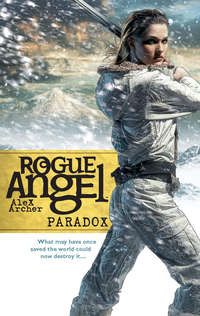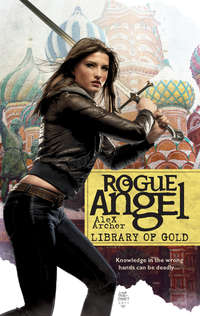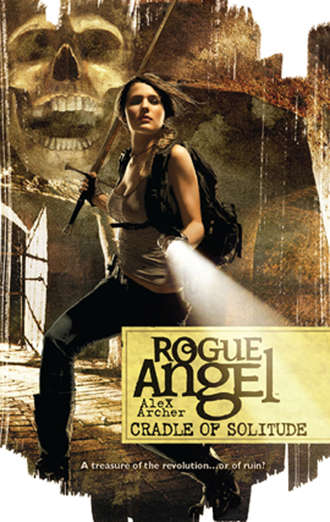
Полная версия
Cradle Of Solitude
Homicide or not, it was their problem to solve.
Several technicians from the museum arrived, summoned earlier by Bernard when he’d realized what it was they were dealing with. The technicians had a portable specimen case with them, essentially a long, flat box that looked like the case for an electric keyboard, and carried several toolkits of different shapes and sizes. Annja stepped out of the way to give them room to work in the narrow confines of the antechamber.
One of the technicians withdrew a video camera from the case he carried and, switching on the high-powered light attached to it, began to pan his way around the entire room in unwitting mimicry of what she had done earlier with the still camera.
When he was finished, he nodded at one of the other team members, who opened another case and began assembling an odd-looking device from the parts inside.
Annja was expecting the skeletal removal to be a long, drawn-out process of removing each bone piece by piece and then placing them into the specimen case, so she was surprised when the man she was watching picked up the device he’d been assembling and moved over to stand next to the skeleton. The device looked like a fire extinguisher, though the canister was blue rather than red, and the operator wore it hanging from his shoulder on a strap. The other end of the hose running out of the top of the cylinder was attached to a gunlike device in his right hand. He turned and aimed the gun at the skeleton.
“Hey! Wait a min—”
She didn’t get any further. The technician squeezed the trigger and began spraying a fine white mist over their mystery man. The mist settled on the skeleton for a moment and then ballooned up into a white foamlike substance that hardened in seconds. Less than five minutes later the entire skeleton was wrapped in a cocoon of hardened foam.
Annja turned to Bernard and asked, “What, exactly, is that stuff?”
The older man smiled. “Do you like it? It’s a new tool my staff and I have come up with in order to transport delicate artifacts.”
He stepped over to the skeleton. “The foam is genetically engineered and completely biodegradable. Flash a UV light on it and it fades away to literally nothing.
But in the meantime—” he reached down and rapped on the foam with his knuckles “—knock, knock, it’s as hard as steel.”
Something that hard must weigh a ton, Annja thought.
“How are you going to move it?”
Bernard eyed the cocooned skeleton with something like genuine affection. “That’s the beautiful part. It’s light as a feather.”
It was, too. With one technician at the feet and another at the head, the skeleton was gently lifted off the ground and placed inside the specimen box with barely an effort.
“Will wonders never cease?”
She was impressed. That foam could have saved her hundreds of hours of effort on earlier digs.
“How long have you been using it?”
Bernard’s expression went sheepish and he mumbled something under his breath.
“I’m sorry, I didn’t catch that,” Annja said.
“That was our, um, first field test.”
If he hadn’t been on the other side of the specimen case, she would have throttled him where he stood. As it was she had to settle for giving him her best glare and vowing to make him pay for using one of her digs as his guinea pig.
They closed up the specimen case and, with one person on either end, carefully lifted it up and carried it out of the room. It wasn’t heavy, but the close confines of the tunnel made it awkward and they took turns carrying it back out to where the catacombs intersected the Metro line. Bernard spent a few minutes talking with Laroche before returning to Annja’s side.
“Help will be here shortly,” he told her.
Ten minutes later a pair of Metro workers arrived, pushing a small handcart along the subway tracks. The newcomers showed one of the museum techs how to operate the cart, the specimen box was loaded on it and, as a group, they set off on the last leg of the walk back to the surface.
As they emerged from the steps leading to the underground, they found a small crowd had gathered around the station entrance, attracted by the museum van that was parked haphazardly on the curb. A few people pointed in her direction and more than one began taking pictures with their cell phones.
As she glanced away, Annja thought, These are not the droids you are looking for. Move along. The memory brought a smile to her face.
Bernard must have noticed, for he asked, “What’s so funny?”
Trying to explain Star Wars humor to a French archaeologist was an exercise in futility so she just shook her head. Thankfully, Bernard let it go, as he was needed to help get the specimen case properly situated into the rack designed to hold it inside the van. Annja glanced once more at the crowd nearby, wondered just what it was that had drawn them and then climbed into the front seat to wait for the others to finish.
A DARK-HAIRED MAN in his mid-forties, dressed in blue jeans and a hooded sweatshirt, glanced at the picture he’d just taken with his cell phone from across the street. He grunted in satisfaction. It wasn’t the best image, but it was good enough. The woman’s companion, Professor Bernard Reinhardt, was well known to them, but she was a mystery. The photo would help them identify her and from there they could assess just what kind of threat she posed to their plans.
Satisfied, he sent the image as part of a text message, dropped his phone into his pocket and started walking down the street.
He hadn’t gone more than a few blocks before the phone rang in response.
“Michaels,” he said, answering it.
The voice on the other end was younger, full of cockiness. “Next time give me something difficult, will ya? Her name’s Annja Creed. She entered France on the fourteenth with an American passport.”
American? Interesting, Michaels thought.
“What’s she doing in Paris?”
“She’s the host of a cable television show that features monsters, myths and legends entitled, appropriately enough, Chasing History’s Monsters.”
Myths and legends. Michaels didn’t like the sound of that. Their contact in the police department had tipped them off that Reinhardt had been called in to examine something discovered during the excavation of the new Metro line. That had brought Michaels down there this morning. His organization had protected certain secrets for generations and any new find, particularly in this area, raised the possibility that some of those secrets might be exposed. He couldn’t allow that to happen.
He hadn’t been concerned at first. They received tips like this at least a handful of times per month and the majority of them led to nothing. Normally he would have sent one of his men to check it out, but he’d been in the area when the call had come in and had decided to deal with it personally. If nothing else, it gave him a chance to stretch his legs and enjoy the change in the weather.
But then he’d seen the crowd that had gathered and watched as the crew removed a large specimen case from the tunnels below and his disinterest changed to concern. A fateful meeting had taken place in this area more than a hundred years before and it wouldn’t bode well for certain people if the facts of that meeting came to light. It was his job to prevent that from happening.
The presence of the American television host certainly had the potential for complicating matters.
“Is she here representing the network?” he asked the man on the other end of the phone.
There was a pause. “I’m not sure yet.”
Michaels didn’t like uncertainties; they tended to create problems later on down the line. His silence must have adequately conveyed his displeasure, for the other man quickly amended his statement.
“I’m working on it, though. I should have an answer shortly.”
“Good. And her relationship with Reinhardt?”
“I’ll have that for you shortly, as well.”
“Next time, call me when you actually know something.”
Ending the call, Michaels slipped the phone back in his pocket and continued down the street to where a black Mercedes waited for him at the curb. As the driver started to get out to open the door for him, Michaels waved him off, climbed in the backseat on his own and then instructed the other man to take him back to the office.
Without a word the driver slid the big car into traffic smoothly and headed off. As they cruised past the van from the museum, Michaels could see the Creed woman sitting in the front seat, seemingly lost in thought while waiting for the rest of the team to finish loading the equipment in the back.
It would be a shame to have to mess up that pretty face, he thought as they drove away.
6
After unloading the specimen case from the van, Dr. Reinhardt had his students carry it downstairs to one of the basement labs. There, he and Annja lost no time getting to work.
They transferred the foam-wrapped skeleton to the top of the long examination table in the center of the lab. Because the skeleton had been in a seated position when it was encased in the foam, they placed a board behind its back for support. Next it was photographed and filmed, just as it had been down in the tunnels. The images would later be combined with the earlier ones to help establish the chain of control over the artifact throughout the examination process. For now, though, Annja took over filming with the video camera as Bernard plugged in a portable UV lamp and prepared to remove the protective foam from the skeleton.
“Ready?” he asked, his fingers poised over the lamp’s power switch.
Annja nodded. She knew she didn’t need to remind him how angry she’d be if the foam had damaged the bones in any way.
She thought about the captain. That’s how she was thinking of him now. She didn’t know who he was yet, but she hoped to uncover his identity in the process of their investigation. She wanted to put a name and maybe even a face to the remains. In the meantime, the title would remind everyone that this had once been a living, breathing person and therefore deserved their respect.
Bernard hit the switch on the lamp and it began humming slightly.
For a few minutes the sound was the only outward evidence that the device was even working. The light it emitted was not visible to the human eye, but eventually the foam began to bubble and break down. It reminded Annja of the head atop a soft drink after being dispensed from a soda fountain.
As the foam broke down, Bernard gently lowered the inclined backboard, inch by inch, until the skeleton rested flat on the examination table, the bones still arranged mostly in the same position in which they’d been discovered.
That’s pretty damn slick, Annja admitted to herself.
Bernard was obviously thinking the same thing, for he threw a huge grin in her direction. It was as if the foam had never existed.
Very carefully, they began separating the bones from the clothing. Each one was carefully measured and then photographed from multiple angles before being placed on another lab table for Bernard to examine more carefully. While he did that, Annja turned her attention to the clothing.
She started with the heavy jacket that had been worn over the uniform. Known as a regimental sack coat, it had a stand-up collar and six CSA buttons running down the front. It was made of wool and had held up pretty well in the cool atmosphere and low humidity of the catacombs. She had no doubt it had once been dyed gray, but the vegetable dye that was used in those days tended to break down quickly and the coat looked more brown than gray at this point.
The blood from the chest wound that had killed their subject had stained the inside of the coat and sealed the lip of the interior pocket closed. When she carefully pried it open, she discovered an envelope inside.
Annja felt her heart starting to beat faster.
Picking up a pair of rubber-tipped tweezers from the selection of tools on the table beside her, she gently inched the envelope out and placed it on a nearby light box where she could examine it in more detail.
“I’ve got something here, Bernard,” she said, and waited for her partner to join her before continuing.
They took multiple photographs to document the specimen. Then, with Bernard’s help, Annja carefully opened the envelope and withdrew the single sheet of paper it contained.
The paper was yellow and brittle with age. Worried that even the slightest pressure might cause an unwanted tear, Annja took her time, unfolding each section using the tweezers. When she had the page lying flat on the light board, she laid a piece of clear laminate over the top, much like the cover on a microscope slide. The laminate would allow her to view the paper clearly, without worrying about accidentally damaging the surface of the letter itself. She breathed a sigh of relief once it was in place.
With the protective cover in place, Annja clamped it down on each corner and then flipped the switch that activated the light board.
When illuminated from below, the ink appeared in sharp contrast to the faded surface of the paper, making it easier to see.
It was a letter.
Annja skimmed through the text, her eyes widening with each line. Upon reaching the signature she gasped in surprise. She heard Bernard whisper, “Mon Dieu,” mere seconds later.
The letter identified the bearer as Captain William Parker, Confederate Navy, and assured the recipient that not only did the captain have the letter writer’s complete confidence but that he was also empowered to act on his behalf with respect to an agreement involving mutual support and satisfaction.
The letter wasn’t addressed to anyone in particular and Annja puzzled over that for a moment until she realized that it had apparently been intended to be hand-delivered to its recipient. That was unfortunate, because knowing who the recipient was might have allowed them to trace things back in the other direction and gain some insight on what Parker, if that was indeed who it was, had been doing in the catacombs.
There was no doubt about where the letter had originated, however, for it had been signed in a thin, spidery script.
Jefferson Davis
President
Confederate States of America
Bernard broke the stunned silence first.
“What was a naval captain bearing a letter of introduction from the president of the Confederate States of America doing in the Paris catacombs?”
Annja shook her head. “I haven’t got a clue, but I promise you this—we’re going to find out!” she said excitedly.
She got up from the examination table and headed over to where she’d set up her laptop computer on a nearby desk. Firing up the web browser, she went to Google and typed Captain William Parker, Confederate Navy into the search bar.
The search produced more than a million hits.
The first one on the list was a short biography from the Naval Historical Center created by the U.S. Department of the Navy. She read parts of it aloud to Bernard, who was using a magnifying glass to examine the letter in more detail.
“Born in New York in 1826…graduated from the Naval Academy and served aboard the Yorktown off the coast of Africa…promoted to lieutenant in 1855.”
She jumped ahead a few lines, focusing in on his wartime service.
“Abandoned the North for the South in 1861 by joining the Confederate Navy. Commanded the gunboat Beaufort during the battle of Roanoke Island in 1862 and also saw action at Hampton Roads and Drewry’s Bluff that same year. In October of 1863 he was promoted to captain and took command of the Confederate Naval Academy, situated aboard the steamboat Patrick Henry in Richmond.”
So far, nothing really unusual, Annja thought. As commander of the Naval Academy, Parker might have had some interaction with the members of the president’s cabinet. But there was nothing that indicated he would have moved in the same social or political circles as the president himself.
Annja kept reading.
“After the war he served as captain of a Pacific mail steamship, was president of Maryland Agricultural College for a time, and even took a post as minister to Korea. He died in Washington in 1896.
“He’s best known for his role in guarding the Confederate treasury during the evacuation of Richmond following Lee’s defeat at Chancellorsville and rumors still persist about his involvement in the disappearance of the treasure.”
“What do you mean disappearance?” Bernard asked.
Annja was already typing Lost Confederate Treasure into Google. This time there were about three hundred thousand hits and she quickly skimmed through several articles to get a sense of the story.
“Apparently Captain Parker was given the difficult job of getting what was left of the Confederate treasury out of Richmond ahead of the invading Union troops. Like President Davis and his cabinet, the treasury made it out of the city aboard one of the last few trains headed for Danville. Once in Danville, the treasure was loaded onto a wagon train, which then set out under Parker’s command, headed for the old U.S. Mint in Charleston. Apparently it never made it. The treasury, all seven hundred thousand dollars of it, disappeared en route.”
Bernard frowned. “Treasure or no treasure, it would seem we’re no further along than we were before finding the letter because there’s no way that man—” he pointed over at the skeleton “—can be Captain Parker if what you’re saying is correct.”
Annja agreed. The letter must have been stolen or given to someone else, an aide perhaps, in order to prevent Parker from falling into just the kind of situation that had killed their subject.
Unless…
She stared at the floor, thinking it through.
When she didn’t say anything for a few minutes, Bernard gently shook her arm.
“What is it?” he asked.
She shrugged. “It’s nothing, really—a hunch, just a long shot….”
But Bernard knew that look and wouldn’t let her off without an explanation. “Out with it. What are you thinking?”
“All right. This is totally off the wall, I know,” she said, “but what if you’re wrong? What if that really is Captain Parker?”
Her colleague’s frown grew deeper. “But how is that possible? Given what you just read to me, I’d say he had a rather public face after the war.”
That was true, but something about the idea nagged at her and she wasn’t ready yet to let it go.
“I don’t know,” she told him. “Maybe he was charged with carrying out some kind of secret negotiation for the president and someone else took his place. Decoys were often used. When the war ended, and Parker didn’t come back, the impostor had to keep impersonating him to keep the secret from getting out.”
Bernard laughed at the idea even as he walked back to his station, and after a moment, Annja couldn’t help but laugh along with him.
It sounded crazy, even to her. After all, the simplest explanation to any problem was often the correct one, to paraphrase the principle behind Occam’s Razor. In this case, it was far simpler to believe the letter was either a forgery or, if it was authentic, that it had been stolen from Parker at some point near the end of the war.
And yet…
It would be a much more interesting story if my theory was right, she thought.
Crazy or not, there was one thing she could do to begin getting at the truth, at least.
Pulling her cell phone out of her pocket, she hit the speed dial and waited for the phone to be answered thirty-six hundred miles away in New York City.
“Doug Morrell’s office.”
“Hi, Doug, it’s Annja.”
Doug Morrell was her producer on Chasing History’s Monsters. He was younger than Annja, more than a bit self-involved and had little to no actual knowledge of historical events prior to the previous decade, but had somehow managed to land his current position regardless of that fact. It probably had to do with his uncanny knack for capitalizing on historical issues and turning them into the kind of television fodder fans of the show ate like candy.
He could be highly annoying, but he had also covered her back on more than one occasion. In an odd way, Annja counted him as one of her friends.
“Who do we know at the Smithsonian?” she asked him.
“What’s this we stuff? Apparently you don’t know anyone. Otherwise, you wouldn’t be calling me.”
Annja had a lot of contacts at the Smithsonian but she’d called on so many people for favors over the years, and knew she’d probably need more in the future, so she wanted to use the show’s contacts if at all possible. Besides, this discovery was of historical significance and had nothing to do with the unusual adventures she was constantly being drawn into. “I meant we as in we the show, not as in you and me,” she told Doug.
“Of course you did. But since you, meaning you, yourself and, well, just you don’t know anyone at the Smithsonian and, miracle upon miracles, I do, this would seem to be an ideal time for me to extract some payment for all the phenomenal episodes I’ve been forced to squelch thanks to your lack of interest and participation.”
He can’t be serious, she thought.
She needed him to focus, and that meant she had to nip this in the bud right away.
“Trust me, Doug,” she said, “no one would have bought the amphibious chupacabra episode. Those injuries were from jellyfish stings, plain and simple.”
“That’s funny. I seem to remember your area of expertise was Renaissance history, not marine wildlife. Or at least it was, last time I checked.”
“It doesn’t take an expert to know that was a stupid idea, Doug.”
“Right. Next you’ll be telling me that you don’t like the ghost shark idea, either.”
She didn’t have to respond to that one; her silence said it all.
“Oh,” Doug replied, indignant. “So that’s how it’s going to be, is it?”
Apparently he’d woken up on the wrong side of the bed that morning. Sighing, Annja said, “Look, Doug, we both know that—”
The dial tone pulsed in her ear.
She pulled the phone away, shook it and listened again.
He’d hung up on her!
“Why that little…jerk!”
Ignoring Bernard’s chuckles from the other side of the room, Annja hit the redial button.
“Doug Morrell’s office.”
“You hung up on me!”
“See that? I knew there was a reason we paid you to host the show. You’re remarkably observant.”
Honey not vinegar, Annja, honey not vinegar, she told herself.
She tried a different approach.
“I’m sorry, Doug. I’d be happy to discuss the ghost shark episode with you when I get back to the States,” she told him, ignoring the fresh round of chuckling that erupted from the other side of the room.
“I want a favor.”
“What?”
“I’d be happy to put you in touch with my contact at the Smithsonian, but it’s going to cost you a favor.”
I know I’m going to regret this, she thought. She sighed. “What is it?”
“Oh, no. I don’t mean right now. Just sometime in the future. You’ll owe me a favor, that’s all. Deal?”
“Owe you a favor? Are you out of your mind?”
“It was good talking with you, Annja. Enjoy the rest of your vacation and I’ll—”
“Fine,” she said, biting off her anger along with the end of the word. She knew she shouldn’t have laughed at the chupacabra thing but owing Doug a favor? No good could possibly come of this.
“What do we need the Smithsonian to do for us?” Doug asked.
Gritting her teeth, she said, “I need to have a letter authenticated.”
“Why didn’t you just call them up and ask yourself? It shouldn’t take more than a few months.”
Annja was shaking her head. “It’s not that simple, Doug. I’m helping the French police with an investigation in the catacombs—”
“Whaaat? The catacombs? You’re running an investigation in the catacombs and you didn’t tell me? I’ll send a crew over immediately.”


